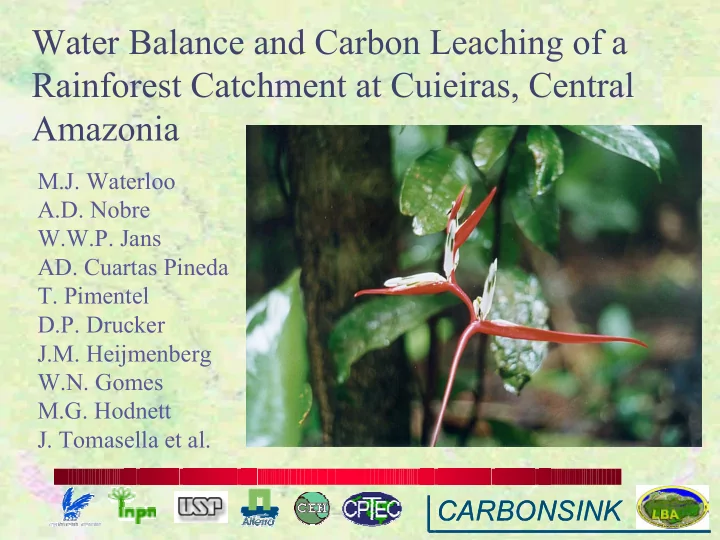

Water Balance and Carbon Leaching of a Rainforest Catchment at Cuieiras, Central Amazonia M.J. Waterloo A.D. Nobre W.W.P. Jans AD. Cuartas Pineda T. Pimentel D.P. Drucker J.M. Heijmenberg W.N. Gomes M.G. Hodnett J. Tomasella et al. CARBONSINK CARBONSINK CARBONSINK CARBONSINK
Objectives Carbonsink Hydrology • Overall objective: to study the fate of carbon once it has been taken up by the vegetation • To quantify amount of the carbon lost from the ecosystem through hydrological pathways in a micro-scale catchment • To assess the sensitivity of the carbon cycle to changes in the soil moisture status CARBONSINK CARBONSINK CARBONSINK CARBONSINK
Site Characteristics • Location: Cuieiras Reserve of INPA • Undisturbed rainforest • Size 6.37 km 2 • Deep soils • Incised plateau area, 40 – 100 m a.s.l.) CARBONSINK CARBONSINK CARBONSINK CARBONSINK
Slope and Groundwater Maps CARBONSINK CARBONSINK CARBONSINK CARBONSINK
Hydrological Measurements • Above canopy rainfall (4 locations) • Throughfall, litter percolate • River water level and flow velocity (Doppler) • Electrical conductivity (EC) and temperature • UV-Vis spectra (NO 3 , DOC, turbidity) • Outflow of coarse/fine particulate organic matter • Groundwater levels, soil moisture status CARBONSINK CARBONSINK CARBONSINK CARBONSINK
Rainfall and Surface Runoff • Period: December 2001 – May 2002 • Total rainfall: 45 10 Rainfall 9 Rainfall (mm), EC (uS/cm) and TOC (mg/l) 40 1851 mm EC TOC 8 35 Discharge 7 • Total river 30 Discharge (m3/s) 6 25 discharge: 5 20 4 809 mm 15 3 10 2 • Difference: 5 1 0 0 1042 mm 01-Dec-01 31-Dec-01 30-Jan-02 01-Mar-02 31-Mar-02 30-Apr-02 30-May-02 CARBONSINK CARBONSINK CARBONSINK CARBONSINK
Possible Sources of C to Streamflow • (Rainfall) and throughfall • Litter percolate, overland flow and lateral sub-surface flow (valley) • Shallow groundwater flow in the valley • Groundwater flow from headwater seepage areas • Deep groundwater flow from plateau areas CARBONSINK CARBONSINK CARBONSINK CARBONSINK
UV-Vis Spectrolyser Measurements • Measures absorbance of radiation in the ultraviolet and visual range (200-700 nm wavelength) • Different chemical components absorb at different wavelengths ( Π -bonds) � absorbance spectra • Reference: distilled water � zero absorbance • Organic substances absorb mainly in the 230 – 340 nm wavelength band CARBONSINK CARBONSINK CARBONSINK CARBONSINK
S::can UV-Vis Spectra Cuieiras 100 Organic carbon Colour, turbidity and suspended NO3 90 Rainfall (4 uS/cm) 80 Throughfall (8 uS/cm) 70 Litter percolate (26 uS/cm) Absorption [m-1] Stormflow, high (32 uS/cm) 60 Stormflow, medium (24 uS/cm) 50 Stormflow, low (22 uS/cm) 40 Baseflow, high (20 uS/cm) 30 Groundwater plateau (12 uS/cm) Groundwater valley (44 uS/cm) 20 10 0 200 250 300 350 400 450 500 550 Wavelength [nm] CARBONSINK CARBONSINK CARBONSINK CARBONSINK
Discharge, EC and DOC 35 6 30 5 Rainfall, EC and DOC 25 4 EC [uS/cm] Streamflow 20 DOC (254 nm) [mg/l] 3 15 Rainfall [mm] 2 10 Streamflow [m3/s] 1 5 0 0 20-Feb 21-Feb 22-Feb 23-Feb 24-Feb 25-Feb 26-Feb CARBONSINK CARBONSINK CARBONSINK CARBONSINK
Differences between water types 60 50 Stormflow-litter Stormflow-valley gw 40 Stormflow-baseflow absorbtion difference [m-1] 30 20 10 0 200 250 300 350 400 450 -10 -20 -30 Wavelength [nm] CARBONSINK CARBONSINK CARBONSINK CARBONSINK
Discharge versus EC and DOC 36 32 EC [uS/cm] and DOC [mg/l] 28 24 20 16 EC 12 DOC 8 0 1 2 3 4 5 6 Discharge [m3/s] CARBONSINK CARBONSINK CARBONSINK CARBONSINK
Carbon Leaching Estimate • Combining the half-hourly stream discharge data with corresponding DOC concentrations yields a carbon leaching value of 0.2 t C ha -1 from December 2001 – May 2002 • Minimum estimate because transport of inorganic carbon and particulate carbon in streamwater, and losses of DOC in groundwater have not yet been included. • Annual value about 0.5 t C ha –1 ??? CARBONSINK CARBONSINK CARBONSINK CARBONSINK
Recommend
More recommend